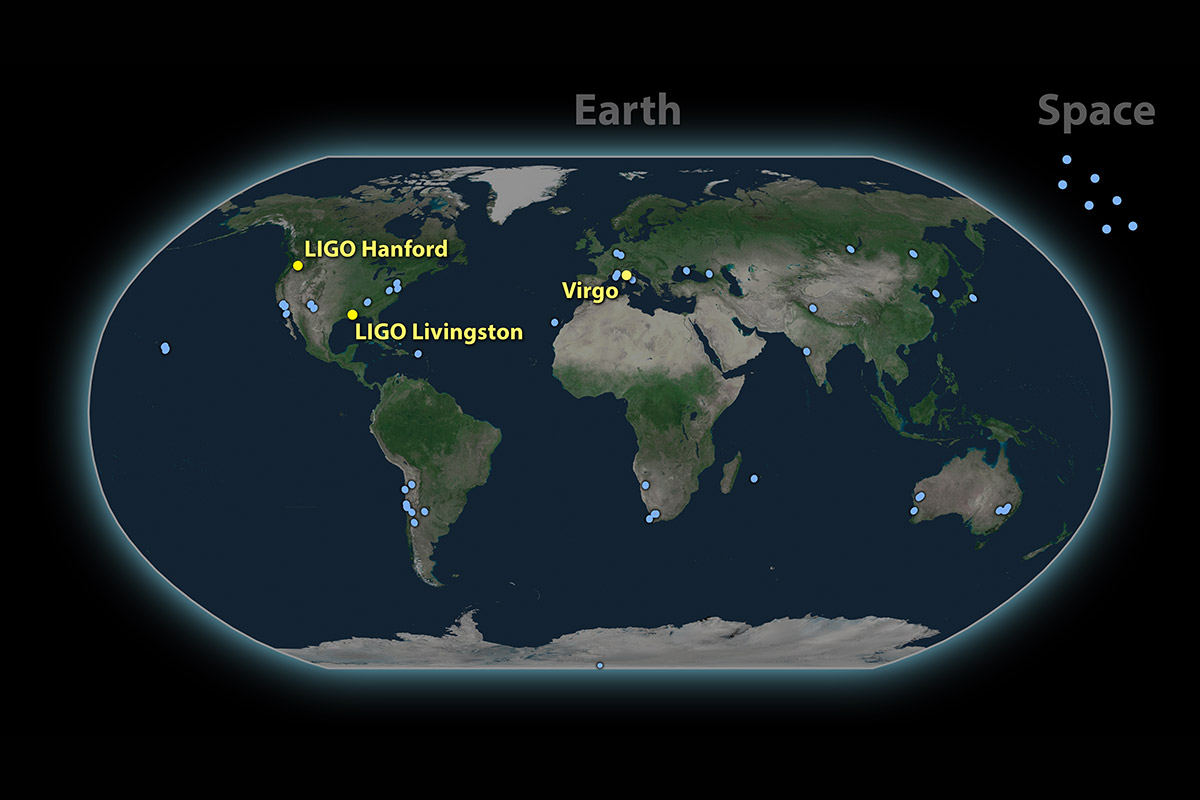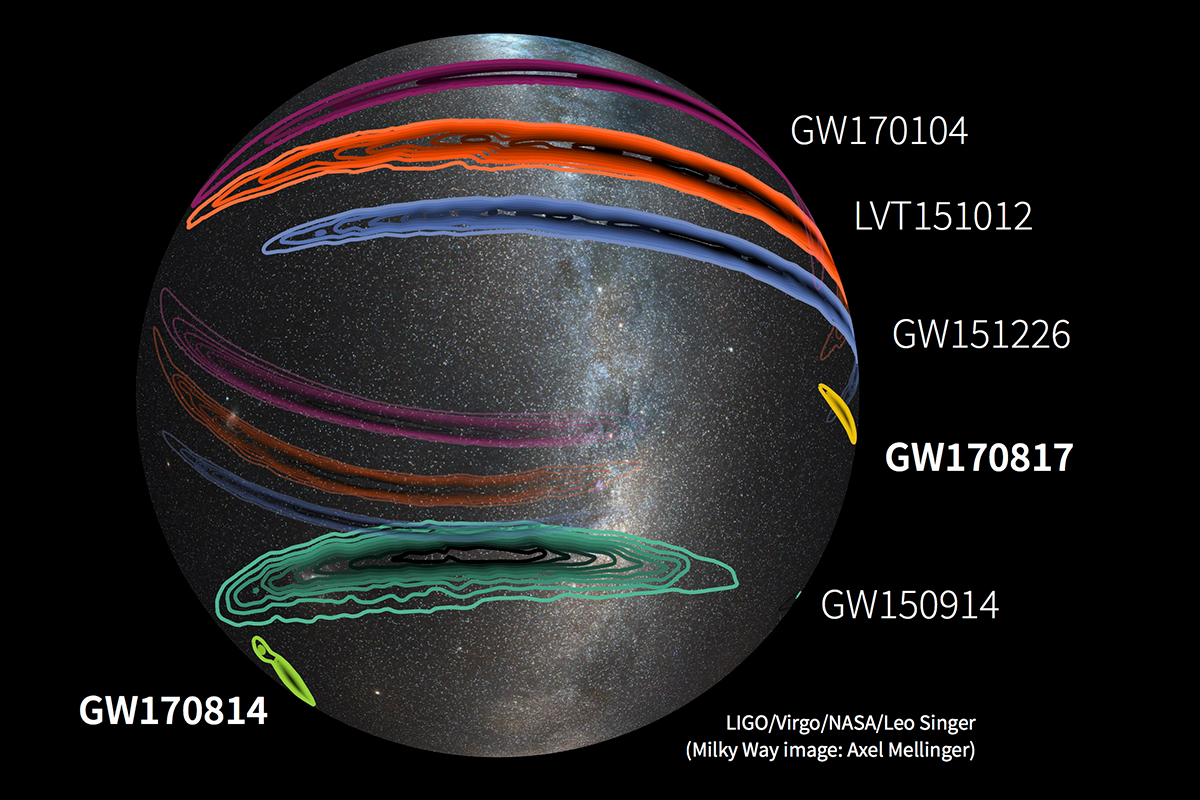Gravitational Waves Ushered in New Era of Astronomy in 2017
The discovery of gravitational waves last year sent ripples through the entire field of physics. They confirmed that space does indeed behave as a substance, which can be stretched and squeezed, as predicted by Albert Einstein's theory of general relativity. They also ushered in a new era of astronomy.
In 2017, scientists detected gravitational waves from an event that was also observed by telescopes: Around 130 million years ago, two neutron stars spiraled toward each other and fused together — a phenomenon known as a kilonova. The rapidly rotating stars whipped up gravitational ripples in space itself. On Aug. 17, the advanced Laser Interferometer Gravitational-Wave Observatory (LIGO) and advanced Virgo observatories on Earth detected those ripples. Because the waves were generated just as the stars merged, the scientists who detected them had enough time to alert astronomers of the light and radiation that would soon follow. [Related: The Greatest Space Science Stories of 2017]
This unprecedented situation enabled astronomers the world over to aim a long list of telescopes at the former pair of neutron stars, obtaining data that spanned the electromagnetic spectrum, from radio waves to visible light, and all the way through to gamma rays.
"Some 3,674 researchers from 953 institutions collaborated on a single paper summarizing the merger and its aftermath," Science staff writer Adrian Cho said in a statement from the journal, which named the discovery its breakthrough of the year today (Dec. 21). The database arXiv.org lists 134 articles that have the gravitational-wave signal, named GW170817, in their titles or abstracts.
The results have already provided scientists with a wealth of information. NASA's Fermi space telescope detected a gamma-ray burst from the source 2 seconds after the gravitational-wave signal ended, demonstrating that merging neutron stars emit gamma rays and that gravitational waves travel at the speed of light, as expected.
Scientists analyzing the light spectrum emanating from the kilonova made another discovery, as well. "We've shown that the heaviest elements in the periodic table, whose origin was shrouded in mystery until today, are made in the mergers of neutron stars," Edo Berger, of the Harvard-Smithsonian Center for Astrophysics (CfA), said in a statement in October. These phenomena are responsible for creating elements like platinum and gold, which are too heavy to be produced by nuclear fusion within stars.

But this event did more than just reveal a fascinating cosmic phenomenon in greater detail than ever before. It marked the beginning of a new era of astronomy and cosmology. "This is a transformation in the way that we're going to do astronomy," LIGO scientist Richard O'Shaughnessy told Space.com shortly after the discovery was announced.
Get the Space.com Newsletter
Breaking space news, the latest updates on rocket launches, skywatching events and more!
Before 2017, scientists could only see events, via light of varying wavelengths; now they can "hear" their effects on space in a new way as well. In fact, scientists often convert the signals from gravitational waves into audio, generating distinctive chirps. The signal from the kilonova lasted around 100 seconds, about 1,000 times longer than the chirp generated by the much heavier black holes.
A new era of astronomy
Scientists are hailing this as the age of multimessenger astronomy, because they can now learn about distant events via two messengers: light, in the form of photons; and gravitational waves.
"Astronomy is somewhat unique among the sciences in that we very rarely get to go sample the things that we're studying," Kevin Marvel, the executive officer of the American Astronomical Society, told Space.com. In the distant past, we could only use our eyes, which have a very limited resolution and are only sensitive to visible light, said Marvel.
Eventually, humans invented the telescope, allowing researchers to get greater resolution when observing the heavens. As scientists discovered other parts of the spectrum, they began building telescopes to view the universe in those wavelengths. "And when you study objects with different parts of the electromagnetic spectrum, you can learn different things about them," Marvel said. "In the infrared, you can tell they're warm, in the ultraviolet, you can tell they're very energetic, etcetera." [First Glimpse of Colliding Neutron Stars Yields Stunning Pics]

"What's happened this year, and the previous year, with gravitational waves, is that we've discovered and used a completely new way to study the universe that is not connected with the electromagnetic spectrum," Marvel said. But unlike light, gravitational waves don't appear to get scattered by dust and gas or blocked by stars, nebulas or galaxies.
In that sense, the development of gravitational-wave astronomy falls somewhere between the discovery of different parts of the electromagnetic spectrum and the invention of the telescope.
Marvel said that as gravitational-wave astronomy develops, it will add to a rich history of collaborative networks. In the 1700s, French astronomer Charles Messier compiled a catalog of nebulas to help eliminate confusion among his colleagues, who often misidentified them as comets. Since then, scientists have set up rapid-response networks for events like supernovas, gamma-ray bursts and other short-lived events. Their means of communication have progressed from mailed letters, through the telegraph, telephone and email, to the instant messages currently informing astronomers of breaking developments.
"This same technique is going to be used with gravitational-wave astronomy," said Marvel. When a signal is detected at the gravitational-wave observatories, the scientists there will send word to their colleagues, who can then point their telescopes at the source.

The quick tracking only works with the help of at least three gravitational-wave observatories: in this case, the two LIGO facilities in the United States and Virgo, in Italy. With two observatories, scientists would only be able to pinpoint the source of the event to a band that stretches across the entire sky, Marvel said. But with three, they could triangulate and locate the specific source of the waves in the sky. Constructing more observatories would add to this precision.
Gravity is the weakest of the four fundamental forces. Only the largest phenomena produce gravitational waves of any measurable strength. "So, gravitational-wave astronomy is going to be focused on the most energetic, destructive events that we know about in the universe," said Marvel.
Besides pointing the way to the universe's most cataclysmic events, gravitational-wave astronomy also provides astronomers with two relatively difficult measurements: The signal pattern gives scientists a precise account of how distant the source is, via general relativity, and its strength is directly proportional to the mass of the objects that created it. This method allows scientists to calculate source's distance directly, without jumping from one known distance to the next following what astronomers call the cosmic distance ladder.
"Not only do you know the distance to these objects because of the pattern, you know the mass of the two progenitor objects and the mass of the final object very, very accurately," Marvel said. "It's really an amazing technique." This ability may help cosmologists better understand how the universe expanded in the past, and what drives its current, accelerating rate, he added.
Email Harrison Tasoff at htasoff@space.com or follow him @harrisontasoff. Follow us @Spacedotcom, Facebook and Google+. Original article on Space.com.
Join our Space Forums to keep talking space on the latest missions, night sky and more! And if you have a news tip, correction or comment, let us know at: community@space.com.

Harrison Tasoff is a science journalist originally from Los Angeles. He graduated from NYU’s Science, Health, and Environmental Reporting Program after earning his B.A. in mathematics at Swarthmore College. Harrison covers an array of subjects, but often finds himself drawn to physics, ecology, and earth science stories. In his spare time, he enjoys tidepooling, mineral collecting, and tending native plants.









